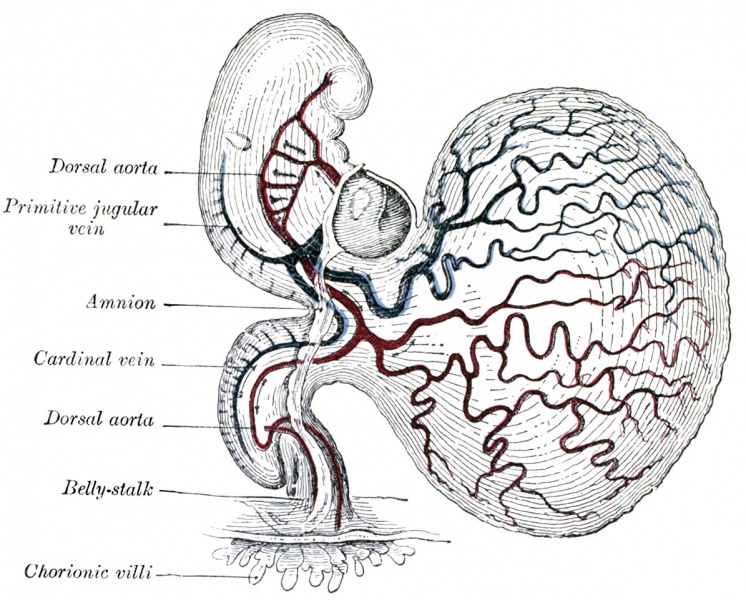File:Gray0459.jpg

Original file (1,195 × 961 pixels, file size: 258 KB, MIME type: image/jpeg)
Fig. 459. Human embryo of about fourteen days, with yolk-sac
(After His.)
The anterior wall of the umbilical orifice are now continuous with the posterior ends of the anterior ventral aorta. With the formation of the tail-fold the posterior parts of the primitive aortse are carried forward in a ventral direction to form the posterior ventral aortae and primary caudal arches. In the pericardial region the two primitive aortse grow together, and fuse to form a single tubular heart (Fig. 460), the posterior end of which receives the two vitelline veins, while from its anterior end the two anterior ventral aortse emerge. The first cephalic arches pass through the mandibular arches, and behind them five additional pairs subsequently develop, so that altogether six pairs of aortic arches are formed; the fifth arches are very transitory vessels connecting the ventral aortse with the dorsal ends of the sixth arches. By the rhythmical contraction of the tubular heart the blood is forced through the aortse and bloodvessels of the vascular area, from which it is returned to the heart by the vitelline veins. This constitutes the vitelline circulation (Fig. 459), and by means of it nutriment is absorbed from the yolk (vitellus.)
- Gray's Images: Development | Lymphatic | Neural | Vision | Hearing | Somatosensory | Integumentary | Respiratory | Gastrointestinal | Urogenital | Endocrine | Surface Anatomy | iBook | Historic Disclaimer
| Historic Disclaimer - information about historic embryology pages |
|---|
| Pages where the terms "Historic" (textbooks, papers, people, recommendations) appear on this site, and sections within pages where this disclaimer appears, indicate that the content and scientific understanding are specific to the time of publication. This means that while some scientific descriptions are still accurate, the terminology and interpretation of the developmental mechanisms reflect the understanding at the time of original publication and those of the preceding periods, these terms, interpretations and recommendations may not reflect our current scientific understanding. (More? Embryology History | Historic Embryology Papers) |
| iBook - Gray's Embryology | |
|---|---|

|
|
Reference
Gray H. Anatomy of the human body. (1918) Philadelphia: Lea & Febiger.
Cite this page: Hill, M.A. (2024, April 24) Embryology Gray0459.jpg. Retrieved from https://embryology.med.unsw.edu.au/embryology/index.php/File:Gray0459.jpg
- © Dr Mark Hill 2024, UNSW Embryology ISBN: 978 0 7334 2609 4 - UNSW CRICOS Provider Code No. 00098G
File history
Click on a date/time to view the file as it appeared at that time.
| Date/Time | Thumbnail | Dimensions | User | Comment | |
|---|---|---|---|---|---|
| current | 18:07, 23 August 2014 |  | 1,195 × 961 (258 KB) | Z8600021 (talk | contribs) | |
| 18:02, 23 August 2014 |  | 1,224 × 1,000 (269 KB) | Z8600021 (talk | contribs) | ==Fig. 459. == {{Gray Anatomy}} Category:Historic Embryology Category:Gray's 1918 Anatomy Category:Human Embryo Category:Heart |
You cannot overwrite this file.
File usage
The following page uses this file:
